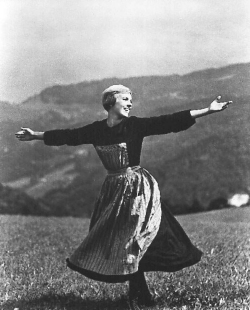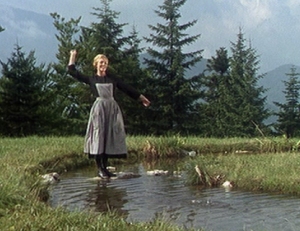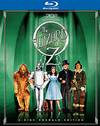





The Sound of Music (1965)
Cast | Crew | Awards | Articles | Dictionary | Bibliography | Downloads | Links | Image Credits
 One
of the most beloved movie musicals of all-time, THE SOUND OF MUSIC had all
the makings of a successful film -- memorable Rodgers and Hammerstein songs,
lush background locations, a talented cast, an experienced production team,
the preceding momentum of a popular stage musical, and most importantly, a
wholesome, sentimental story with sympathetic heroes, historic villains and
broad family appeal. Yet the international blockbuster that resulted
when all these elements finally came together in the spring of 1965 was
altogether greater than the sum of its parts. One
of the most beloved movie musicals of all-time, THE SOUND OF MUSIC had all
the makings of a successful film -- memorable Rodgers and Hammerstein songs,
lush background locations, a talented cast, an experienced production team,
the preceding momentum of a popular stage musical, and most importantly, a
wholesome, sentimental story with sympathetic heroes, historic villains and
broad family appeal. Yet the international blockbuster that resulted
when all these elements finally came together in the spring of 1965 was
altogether greater than the sum of its parts.
By the standards of an era when civil rights, the space program, the Great Society and the Vietnam conflict dominated American headlines, THE SOUND OF MUSIC is old-fashioned and glossy, lacking the gritty realism and appeal for social consciousness that dominates other movies of the mid-1960s. Nevertheless, audiences then and now can't get enough of it; because for all its breathtaking scenery and cheery optimism, the film's characters are individuals with credible personal and political struggles, both externally challenged and internally troubled, for whom the audience comes to care. And caring, generations of viewers have been reminded of the importance of family and the universality of music; they have taken heart in the idea that "when the Lord closes a door, somewhere He opens a window" and been inspired to "climb every mountain" in search of a dream. In short, THE SOUND OF MUSIC is the ultimate feel-good movie, and its popularity is likely to continue as long as humanity's need for an occasional shot in the arm of hope, happiness and harmony. |
 Julie Andrews was Hollywood's most promising up-and-coming musical star when she was chosen to play THE SOUND OF MUSIC's leading role, Fraulein Maria, in the winter of 1963. An established star of the Broadway and London stages, Andrews was just beginning to make her mark on the film industry, having recently completed production on her first movie musical, MARY POPPINS (1964). Although it had not yet been released, THE SOUND OF MUSIC director Robert Wise arranged to screen some footage from MARY POPPINS at the Disney studios in an effort to evaluate Andrews' potential as a musical screen star. Impressed with what he saw and confident she could bring added depth to the role made famous on Broadway by the legendary Mary Martin, Wise quickly signed Andrews to play the impetuous postulant upon whose shoulders the success of THE SOUND OF MUSIC would rest. Needless to say, she did not disappoint. Not only did Andrews earn an Oscar for her performance in MARY POPPINS (1964) only a month after THE SOUND OF MUSIC was released on Memorial Day weekend 1965; she also earned a second Best Actress Academy Award nomination for her performance in THE SOUND OF MUSIC itself. Although this early in her film career, some of her gestures are still (understandably) somewhat stagy, the earnestness and rebellious spirit Andrews brings to the role of Maria lend an additional level of humor to the film's light moments and sincerity to the more serious scenes, keeping the movie's storyline from becoming too fanciful or saccharine. And with a voice like Andrews', its easier to understand how a devoted nun-in-training could permit a simple abbey rule against singing to force her outside the convent walls and into the real world where all her adventures begin. Though THE SOUND OF MUSIC won the Academy Awards for Best Picture of 1965 and Best Director (Robert Wise) along with three other statuettes, among its five unrequited nominations were three in the aesthetic categories of art/set decoration, costume design and cinematography -- all of which were awarded to the other major historical epic of 1965, David Lean's DOCTOR ZHIVAGO. That said, cinematographer Ted McCord's location photography of Salzburg, Austria and the surrounding Alps -- especially evident in the helicopter shots during the pre-titles opening sequence -- is authentically breathtaking and can only be properly appreciated when seen in all its 70mm glory on the big screen. Video Clip from the pre-titles opening sequence:
|
 We first meet Maria basking wimple-less in the sunshine and singing her heart out on top of a mountain:
"The hills are alive with the sound of music -- with songs they have sung for a thousand years. The hills fill my heart with the sound of music. My heart wants to sing every song it hears. "My heart wants to beat like the wings of the birds that rise from the lake to the trees. My heart wants to sigh like a chime that flies from a church on a breeze; to laugh like a brook when it trips and falls over stones on its way; to sing through the night like a lark who is learning to pray. I go to the hills when my heart is lonely. I know I will hear what I've heard before. My heart will be blessed with the sound of music, and I'll sing once more." But Maria gets a little carried away up on the Untersberg mountain and is late returning to the abbey. This will have consequences and she well knows it.
(For help opening the multimedia files, visit the plug-ins page.) |
|
Go to the next page. |
| Now in Print! |
|---|
| Now on DVD! |
|---|
Buy Videos & DVDs |
|
Buy Movie Posters |
|
Buy Movie Posters |
|
Classic
Movie Merchandise |
|
![]() Printer-friendly version.
Printer-friendly version.
![]() Return
to the top.
Return
to the top.
Last updated:
June 21, 2010.
Reel Classics is a registered trademark of Reel Classics, L.L.C.
© 1997-2010 Reel Classics, L.L.C. All rights reserved. No
copyright is claimed on non-original or licensed material.
Terms of
Use.









